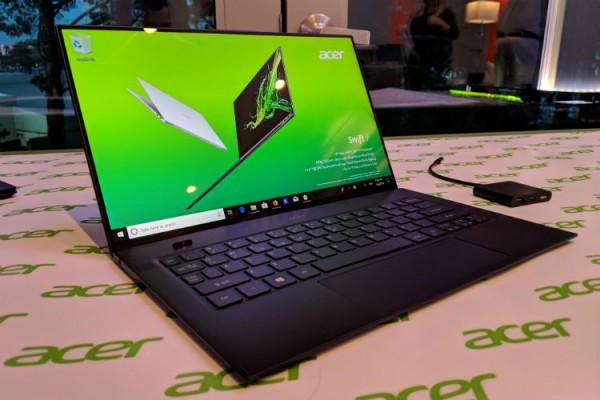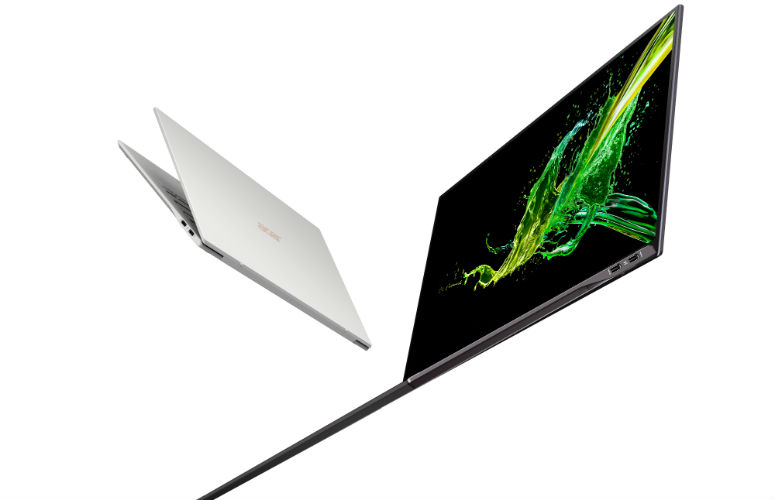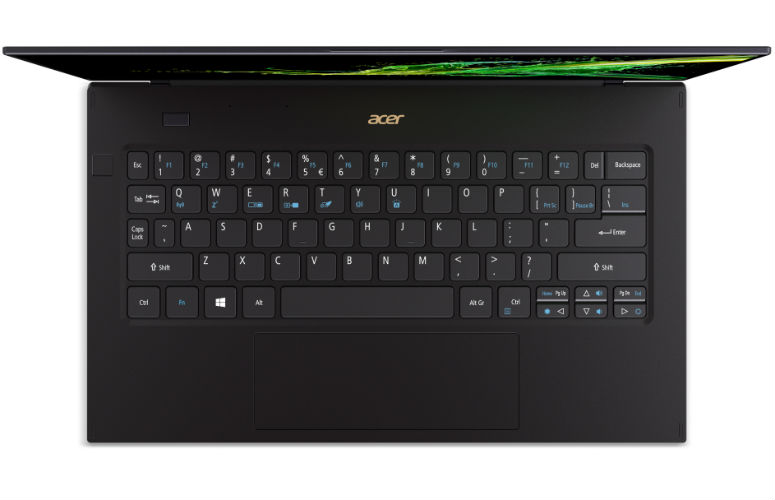Acer Swift 7 Hands-On: Incredibly Small, Impossibly Thin
Editor's Note: We have updated this post with hands-on impressions from CES 2019.
LAS VEGAS—Acer is following up the world's thinnest clamshell laptop with an even smaller model. At CES 2019, the laptop manufacturer unveiled a stunning new version of the 14-inch Swift 7. We got some hands-on time with the laptop, and trust us, you need to see this thing in person. Not only is the Swift 7 as thin as the previous model, but now it's even more compact thanks to its negligible display bezels.

The Swift 7 will be available in the U.S. in May and at $1,699 when configured with a Core i7 CPU, 8GB of RAM and a 256GB SSD. You'll also be able to opt for a pricier version with 16GB of RAM and a 512GB SSD.
I was blown away the first time I viewed the Swift 7 from the side, and dumbfounded when I remembered that it sports a large, 14-inch display. Acer shrunk the new Swift 7's X and Y axis to 12.5 x 7.3 inches, making it even more portable than its predecessor. Better yet, this 1.96-pound featherweight retains the sub-1 centimeter (0.39-inch) chassis and 92 percent screen-to-body ratio found on last year's ultrabook.
| Row 0 - Cell 0 | Acer Swift 7 (2019) |
| Starting Price | $1,699 |
| Display | 14-inch, 1080p |
| CPU | Intel Core i7-8500Y |
| RAM | 8GB, 16GB |
| Storage | 256GB, 512GB |
| Ports | 2 Thunderbolt 3, headphone |
| Size | 12.5 x 7.5 x 0.4 inches |
| Weight | 1.96 pounds |
Those are the sort of dimensions we typically see on a 13-inch laptop, not one with a 14-inch display like the Swift 7. Speaking of which, Acer claims the notebook's 1080p touch screen can cover 100 percent of the sRGB color gamut and reach 300 nits of brightness. The screen on the pre-production unit we previewed looked plenty bright and vivid. Also interesting to note is that the Swift is one of the first laptops to use Gorilla Glass 6.

The new Swift 7 is made of magnesium alloy, which is meant to keep weight down without compromising on durability. Acer says the material is several times stronger and up to 35 percent lighter than aluminum alloys. With such a thin design, it's no surprise that the Swift 7 is light on ports. However, you'll at least find dual Thunderbolt 3 inputs and a headphone/mic jack. A far more frustrating concession of the thin chassis is that the Swift 7 has a pop-up webcam (or nosecam, in this case) build into the deck. There hasn't been a webcam located below the display that we've liked so far, so my expectations are low.
MORE: Lowest Weight Laptops
Stay in the know with Laptop Mag
Get our in-depth reviews, helpful tips, great deals, and the biggest news stories delivered to your inbox.
The Swift 7 is powered by the latest 8th Gen Intel Core i7-8500Y CPU. The processor probably won't provide the same performance as U-series chips because they are specifically designed for thin, fanless laptops, however, low-power CPUs tend to enable longer battery life. Acer rates the Swift 7's endurance at 10 hours.

We don't expect a miracle from the Swift 7's backlit keyboard given how thin this laptop is, but Acer is claiming a pretty respectable key travel of 1.1 millimeters. That's not quite up to our 1.5mm preference, but neither was the surprisingly comfortable keyboard found on its predecessor. For what it's worth, the keys felt snappy in the short time I spent with the laptop.
Acer added some nice security features in the new Swift 7. The laptop's power button doubles as a fingerprint sensor for secure and convenient authentication and a push-to-open webcam should give reassurance that nobody is snooping on you, albeit, at the expense of photo quality.
We will have a better idea of how this ultrathin laptop performs when we receive a unit to review. Until then, stay tuned for more CES 2019 coverage.
Phillip Tracy is the assistant managing editor at Laptop Mag where he reviews laptops, phones and other gadgets while covering the latest industry news. After graduating with a journalism degree from the University of Texas at Austin, Phillip became a tech reporter at the Daily Dot. There, he wrote reviews for a range of gadgets and covered everything from social media trends to cybersecurity. Prior to that, he wrote for RCR Wireless News covering 5G and IoT. When he's not tinkering with devices, you can find Phillip playing video games, reading, traveling or watching soccer.

